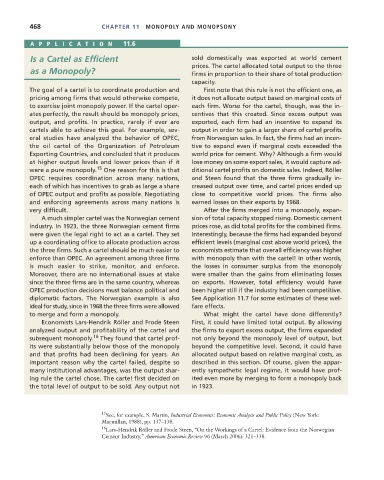Page 494 - Microeconomics, Fourth Edition
P. 494
c11monopolyandmonopsony.qxd 7/14/10 7:58 PM Page 468
468 CHAPTER 11 MONOPOLY AND MONOPSONY
APPLICA TION 11.6
Is a Cartel as Efficient sold domestically was exported at world cement
prices. The cartel allocated total output to the three
as a Monopoly? firms in proportion to their share of total production
capacity.
The goal of a cartel is to coordinate production and First note that this rule is not the efficient one, as
pricing among firms that would otherwise compete, it does not allocate output based on marginal costs of
to exercise joint monopoly power. If the cartel oper- each firm. Worse for the cartel, though, was the in-
ates perfectly, the result should be monopoly prices, centives that this created. Since excess output was
output, and profits. In practice, rarely if ever are exported, each firm had an incentive to expand its
cartels able to achieve this goal. For example, sev- output in order to gain a larger share of cartel profits
eral studies have analyzed the behavior of OPEC, from Norwegian sales. In fact, the firms had an incen-
the oil cartel of the Organization of Petroleum tive to expand even if marginal costs exceeded the
Exporting Countries, and concluded that it produces world price for cement. Why? Although a firm would
at higher output levels and lower prices than if it lose money on some export sales, it would capture ad-
were a pure monopoly. 15 One reason for this is that ditional cartel profits on domestic sales. Indeed, Röller
OPEC requires coordination across many nations, and Steen found that the three firms gradually in-
each of which has incentives to grab as large a share creased output over time, and cartel prices ended up
of OPEC output and profits as possible. Negotiating close to competitive world prices. The firms also
and enforcing agreements across many nations is earned losses on their exports by 1968.
very difficult. After the firms merged into a monopoly, expan-
A much simpler cartel was the Norwegian cement sion of total capacity stopped rising. Domestic cement
industry. In 1923, the three Norwegian cement firms prices rose, as did total profits for the combined firms.
were given the legal right to act as a cartel. They set Interestingly, because the firms had expanded beyond
up a coordinating office to allocate production across efficient levels (marginal cost above world prices), the
the three firms. Such a cartel should be much easier to economists estimate that overall efficiency was higher
enforce than OPEC. An agreement among three firms with monopoly than with the cartel! In other words,
is much easier to strike, monitor, and enforce. the losses in consumer surplus from the monopoly
Moreover, there are no international issues at stake were smaller than the gains from eliminating losses
since the three firms are in the same country, whereas on exports. However, total efficiency would have
OPEC production decisions must balance political and been higher still if the industry had been competitive.
diplomatic factors. The Norwegian example is also See Application 11.7 for some estimates of these wel-
ideal for study, since in 1968 the three firms were allowed fare effects.
to merge and form a monopoly. What might the cartel have done differently?
Economists Lars-Hendrik Röller and Frode Steen First, it could have limited total output. By allowing
analyzed output and profitability of the cartel and the firms to export excess output, the firms expanded
subsequent monopoly. 16 They found that cartel prof- not only beyond the monopoly level of output, but
its were substantially below those of the monopoly beyond the competitive level. Second, it could have
and that profits had been declining for years. An allocated output based on relative marginal costs, as
important reason why the cartel failed, despite so described in this section. Of course, given the appar-
many institutional advantages, was the output shar- ently sympathetic legal regime, it would have prof-
ing rule the cartel chose. The cartel first decided on ited even more by merging to form a monopoly back
the total level of output to be sold. Any output not in 1923.
15 See, for example, S. Martin, Industrial Economics: Economic Analysis and Public Policy (New York:
Macmillan, 1988), pp. 137–138.
16 Lars-Hendrik Röller and Frode Steen, “On the Workings of a Cartel: Evidence from the Norwegian
Cement Industry,” American Economic Review 96 (March 2006): 321–338.

